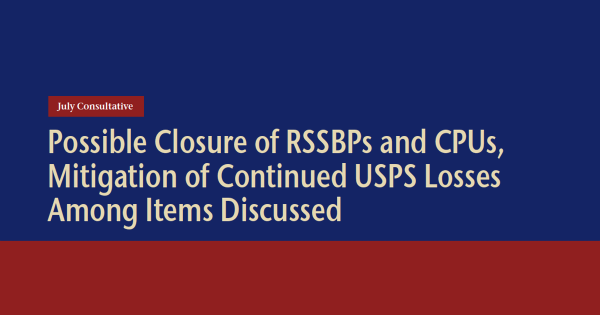July 2025 Consultative
NAPS President Ivan D. Butts, Executive Vice President Chuck Mulidore, Secretary/Treasurer Jimmy Warden and Executive Board Chair Chuck Lum attended the July 15 Zoom consultative meeting. Representing the Postal Service were Bruce Nicholson, James Timmons and Paulita Wimbush, Labor Relations Policies and Programs.
Agenda Item #1
Currently, NAPS said, there is a lot coming from Postal Headquarters concerning offices’ daily and weekly budgets versus SPLY. NAPS has been made aware there are discussions about a possible negative flex to each office based on the decrease in parcel volume, not small parcels and rolls (SPR) volume. The assumption is there is a loss of LDC 22 hours based on a loss of parcel volume. However, in DOIS, the SPR volumes are much higher than actual parcels, which presents a problem in LDC 22. The SPRs that fit are sorted into the carrier’s case. Those that do not fit into the case are trayed for delivery separately on street time. The problem is there is no delivery time credited on the street for the actual SPR delivery. Examples: A park & loop route—Not all SPRs in a relay fit in the carrier’s satchel. Those that do not fit the satchel must be dropped off to the customer like a parcel. No credit currently is given. An NDBCU route—Most NDBCUs have only two parcel lockers available. If the SPR does not fit in the ND-BCU mail slot, the carrier must drop it off at the customer’s front door. No credit currently is given. A curbside delivery route—If a SPR does not fit in the mailbox, it must be dropped off like a parcel at the customer’s door. Generally, curbside routes have a longer distance to the front door from the vehicle. No credit currently is given.
We are not aware of a “negative flex.”
Agenda Item #2
NAPS has been made aware of Retail Systems Software Business Partners (RSSBPs) and Contract Postal Units (CPUs) being given a 120-day notice of closure effective Sept. 30, 2025. Many of these businesses have been working with the Postal Service for more than 20 years. There may be USPS retail facilities within several miles of these locations, but RSSBPs and CPUs help customers, bring in revenue and reduce post office wait times in line. NAPS is concerned these closures will increase C360 cases, increase wait times in line and generally increase workloads at nearby postal locations without any increase in staffing. What solution will the USPS offer to mitigate these potential issues?
The proposal takes into account a number of considerations, including:
- National trends: A continued national decline in mail volume and walk-in transactions have caused a significant decrease in the retail workload across the USPS network.
- Retail efficiency: Consolidating CPUs supports efforts to improve productivity across the USPS retail network. Walk-in retail activity will be moved into fewer locations, resulting in an increase in earned revenue and improved staffing alignment. Additionally, the consolidation analysis included an evaluation of CPUs that had a nearby USPS retail facility, which would enable customers still to retain convenient access to retail services, even if a CPU was identified for potential closure.
- Earned workhours: An increase in walk-in transactions from realignments will generate more earned hours at the USPS retail sites, which, in turn, supports earned staffing at those locations. We understand the apprehension surrounding potential increases in workload, customer wait times and complaints. We are committed to evaluating the actual impacts on service and employees and will work closely with local leadership to monitor and address any issues related to the implementation of the consolidations. Our primary goal remains to operate more efficiently and sustainably while continuing to serve our communities with reliable access to retail services.
Agenda Item #3
The USPS lost $9.5 billion in FY24. NAPS asked what categories and percentages in each category contributed to the $9.5 billion in losses. Examples include, but are not limited to:
- APWU grievance expenses/payouts
- NALC grievance expenses/payouts
- S&DC startup expenses
- Motor vehicle at fault accident payouts
- Overtime paid to craft employees
- New delivery vehicle purchases
- EAS travel for training
- USPS Headquarters executive bonuses
Obviously, these losses cannot be sustained over the long term and contribute to less money being paid to EAS employees in terms of Pay for Performance. What actions are the USPS taking to mitigate these losses and return the agency to viability?
We disagree with NAPS’ assertion on this agenda item. The examples NAPS provided are not NPA indicators used at the national level for PFP purposes. S&DC startup expenses and new delivery vehicle purchases are capital expenses that are not measured under the National Performance Assessment (NPA). EAS travel for training is funded and is not relevant to EAS PFP. There may be occasions when it is necessary to travel for certain training events. NAPS has made numerous requests in past meetings for the USPS to provide additional and adequate training. In addition, training benefits the employees and improves performance of NPA indicators. Regarding examples of grievance expenses/payouts, motor vehicle at fault accidents payouts and overtime paid to craft employees, local field management has an important part (a responsibility) in administering postal policies and being consistent with collective bargaining agreements and controlling grievance expenses/payouts. Employee compliance with safety procedures that prevent motor vehicle at fault accident payouts is a primary responsibility of all supervisors and managers. Also, ensuring efficiency and managing attendance helps minimize overtime paid to craft employees.
